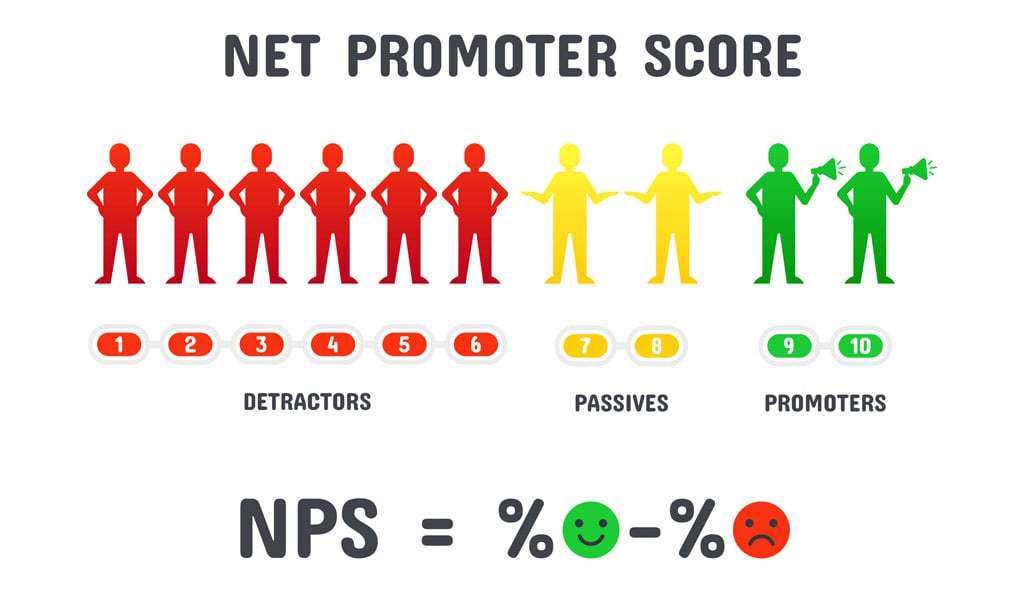
Keeping an eye on your Net Promoter Score can be a great way of making sure your business is staying on track with your customer engagement goals. However, boosting your NPS in the right way is more complicated than simply chasing a higher number. In this article, we’ll tell you how to treat your NPS as a business state of mind to drive more goal-driven results for your company. Let’s take a look.
What Is Net Promoter Score (NPS)?
Walt Disney once said, “Do what you do so well that they want to see it again and bring their friends”. This is what NPS is at its core!
NPS is a popular customer experience metric used by many businesses around the world. Put simply, it’s a measurement system that allows you to track and increase the likelihood of customers recommending your business to others.
Here’s how it works:
Customers are asked a simple question like “How likely are you to recommend us [the company] to a friend or relative?”. They are presented with a scale that goes from 0-10 and will choose a number that best reflects their answer.
Customers who pick a number between 0 and 6 are called detractors. Detractors are unsatisfied with your company. They have the power to harm your brand or limit your growth through negative word of mouth. However, it’s also important to recognize that detractors have another power too. They will tell you what they don’t like. They will tell you what you need to fix about your company.
Customers who pick numbers 7 or 8 are called passives. Passively satisfied people are ambivalent about your services. They could be susceptible to your competitor’s offerings.
Customers who pick numbers 9 or 10 are called promoters. Promoters are your word of mouth marketing force. These are the people who will actively recommend you to their friends and family, and also the people who will be willing to spend more on your products. Promoters are also more likely to try your new products and services than people in the other categories. Your goal should be to please promoters and keep them happy!
How to Calculate Your NPS Score
NPS is calculated using a simple equation. First, you need to find the percentage of promoters, passives, and detractors. Then you take the percentage of detractors away from the percentage of promoters. This will give you the NPS score. Let’s look at an example.
200 people were asked the question “How likely are you to recommend our company to others?”. 120 people respond to this survey, these are the results you will use to calculate your NPS.
Out of the 120 respondents:
- 63 were promoters.
- 43 were passive.
- 14 were detractors.
To find the %:
63/120*100 = 52.5%
43/120*100 = 35.8%
14/120*100= 11.66%
NPS:
52.5 – 11.66 = 40.84%
You will want to increase your NPS score to increase customer loyalty and drive revenue.

NPS as a State of Mind
At its core, NPS is about creating a business that customers want to come back to and want to recommend. This is exactly what Walt Disney was talking about, and he didn’t mention the NPS score at all. Keeping track of your NPS score is an important way of measuring how successful you are in this area, but it’s not everything. Instead, you need to look beyond the score and see increasing customer satisfaction as a core business goal. You need to learn how to improve your NPS without focusing on the score, and this is done through mindset, culture, and strategy.
1. Stop Seeing NPS as Just a Number
NPS is much more than a number. Sometimes businesses focus so much on the number that they can become blind to the opportunities of engagement and improvement right in front of them.
The Net Promoter Score can be seen as a guide or a signal of how effective your customer engagement strategies are. The NPS shouldn’t be your focus, but rather your customer engagement tools and strategies. Remember, tools are only useful if you use them in the right way. An ax is great for chopping down trees, but it’s far from effective if you need to extract the whites from an egg. The NPS isn’t a tool, NPS strategies (like this one) can be a tool. But the NPS itself is just a metric. You can’t see a meaningful difference in your NPS by changing the wording of the question or sending it out to more respondents. This is why you should focus on improving customer satisfaction rather than increasing your NPS.
This may seem like an obvious point, but you’d be surprised how many businesses get overly focused on the number. These businesses lose sight of the real goal: to increase customer loyalty and create better products. They simply become a slave to the number, hoping it will go up or down without developing meaningful strategies.
2. Consistency as a Mindset
Consistency is hugely important in business in 2020. For many businesses in the digital age, this starts with shifting to an omnichannel approach. When you unify your systems and say goodbye to siloed methods of working, you create a more consistent experience for your customers. Your customers are fluid in their preferences. They might prefer to call you if they are in a hurry but might prefer to use live chat if they are at work and have a less urgent issue. Providing an inconsistent experience across different platforms can drive customers away by causing frustration and confusion.
Having an omnichannel approach, complete with an omnichannel platform, helps shift the mindset within a business. Employees benefit from having a more consistent and logical experience in their day to day activities. Employees become adept at knowing how to best help customers because they have everything they need at their fingertips. When you do away with silos, employees also feel more empowered to ask questions and work with fellow employees, even if these employees work on a different team. The whole business essentially becomes one team, and this is reflected in your culture and voice when talking to customers.
Businesses often start with an omnichannel approach and then find that they also develop brand consistency. One study found that consistent brand representation across all platforms can increase revenue by 23%. This isn’t an area you can afford to ignore, and when you start giving it more attention, you’ll find your NPS start to rise.
3. Focus on Promoters
What do your promoters love about your company? Your promoters are uniquely beneficial to your company for several reasons that go far beyond the willingness to buy your products. These customers are highly engaged. They are much more likely to answer detailed surveys with lots of questions than customers in other groups. One of the main issues with surveys is that they are only useful if you can get people to answer them. This might sound painfully obvious, but it’s something many people miss when crafting a new customer survey or questionnaire.
Surveys are a great way to gain valuable information about your customers’ preferences and spending habits. The mistake many businesses make is that they forget that the customer has to want to fill out the survey. Your customers don’t work for you – they are not obligated to answer your questions. So, when you ask your customers to fill out a 10-question survey, they are aware that there is a benefit to both them, and you, but more to you. They might get better products or a better experience by answering the questions, and this will be their main motivation for answering the survey. From a business perspective, the purpose of sending out the survey is to better learn how to sell to your customers by listening to them.
This means that when you send out a survey to a broad range of customers, your goal should be to get as many answers as possible. This means making the survey easy to answer and as convenient as possible. Short, easy to read questions, and not many of them. That’s the way to do it.
However, your promoters are already champions of your company. They are engaged enough that they would be willing to spend more time engaging with you by answering longer surveys.

4. Focus on Detractors
Detractors will tell you exactly what they don’t like about your business if you let them. If you can listen and respond to your detractors, addressing their needs, then you can convert them into promoters. However, it’s also important to recognize that not all problems are meant to be fixed. If you find that many of your detractors complain about something that is a core business value for you, then the problem could lie in your marketing, not the way you do business.
For example, let’s say you have a loyalty card made from recycled paper materials. Environmental sustainability is a core business value for your business, and you primarily sell environmentally friendly products. If you get several detractors complaining that your cards aren’t durable enough and that you should use plastic instead, then these might not be the types of customers you want to attract. How did you attract these customers in the first place? Is there something about your marketing that leads to unrealistic expectations?
5. Create a Customer Experience Mission Statement
Mission statements are a great way to keep you on track with your customer experience goals. They can both inspire your employees and help hold you accountable to your goals. To create an effective mission statement, it needs to be actionable, measurable, and trainable.
- Actionable – How will you deliver excellent customer experience?
- Measurable – How will you track that you are successfully executing your actions?
- Trainable – Do your employees understand your mission statement? Can they put it into practice from day one at the company?
6. Be Transparent with Customers
Transparency is hugely important in the age of disinformation and intense scrutiny. With social media, information (good or bad) travels fast. It’s always better to be in control of a situation, telling the narrative yourself, than having someone else tell your story for you. This means that if you find an issue with one of your products, are having technical issues, or something else, then tell your customers straight away.
Transparency can also mean setting expectations. Be upfront and honest about your opening times, when customers can call you, and so on. Be honest about what your product can do, and who it serves most effectively. If you are so focused on selling that you’ll sell to anyone, maybe even bending the truth to make a sale, then you’ll end up with a lot of unhappy customers.
7. Take Care of Your Employees
Your employees, and particularly the customer-facing ones, are on the frontline of your business. Through their words and their actions, they help shape customer experiences. If a customer has a bad interaction with an agent, then they form a negative opinion on your company. If you make employee happiness a key part of your strategy, then your employees will be better equipped to deliver great experiences.